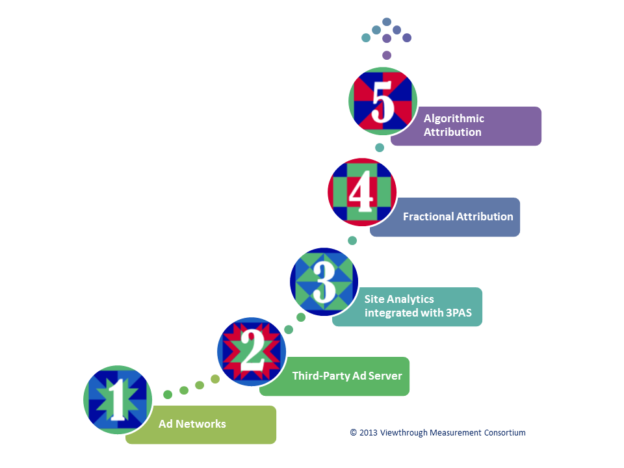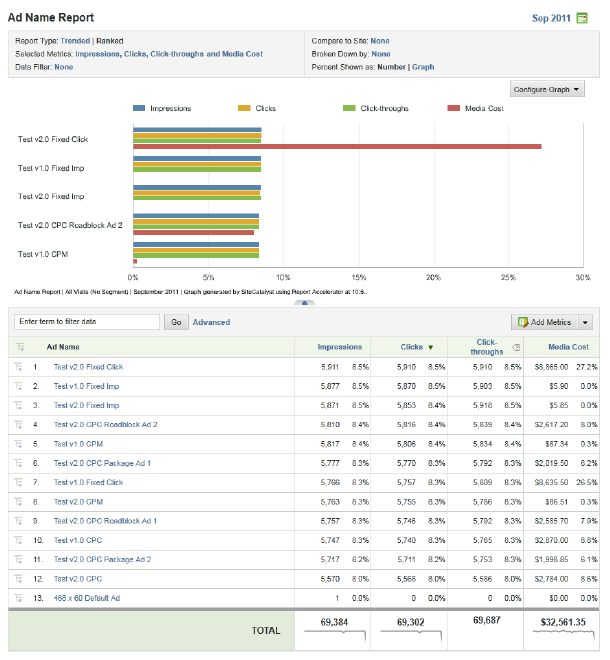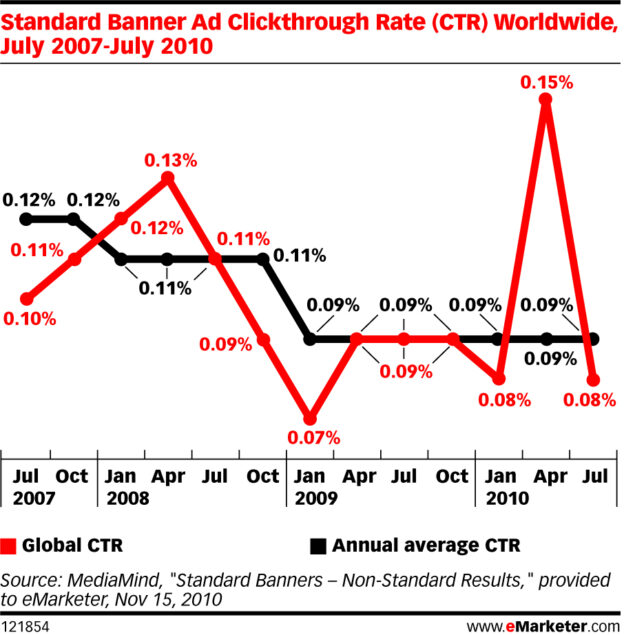While we don’t always agree with IAB when it comes to viewthrough, a recent post on AdExchanger deserved support: IAB Vs Mozilla: Randall Rothenberg Takes The Gloves Off
Author Archives: mrviewthrough

Buying a Stairway to Attribution – Part 2 (Getting Integrated)
In the last post, Buying a Viewthrough Stairway to Attribution – Part 1, we looked at the first two steps in viewthrough measurement. These two are easy enough and come from an ad network partner or your agency’s display ad server.
Proceed to Step #3 brings together the two very different worlds of display ad servers and site-side analytics systems. At a high-level, these systems notoriously have measurement discrepancies – ad servers are typically server-side while modern site analytics solutions are all or in-part JavaScript based. In addition, there are different filters being used to exclude internal and robotic traffic.
Nonetheless, an integrated solution can be a game-changer for most digital advertising clients. Most are still struggling to understand the latent (non-click) but now quantifiable brand influence of display media on subsequent destination site behavior.
- Site Analytics integrated with Third-Party Ad Servers (3PAS)
- Upside: A really powerful way to advance viewthrough measurement capabilities is to leverage the data contained in the digital media agency’s ad server. From that standpoint, the digital marketer is combining the best of both worlds: a) digital media agency-of-record’s ad server platform and b) existing in-house site analytics system-of-record. There are two distinct approaches, either taking the analytics platform and bringing it up the funnel into the ad delivery through ad tagging or make the site analytics platform talk to the ad server via integration. IBM Coremetrics takes the former approach and Omniture Genesis takes the latter. This approach is potentially very powerful because it considers all digital channels, both paid and unpaid in one place. For this reason, attribution can be considerate of all the digital channels being employed. Site analytics technologies that have provided related information to the VMC are included in the Viewthrough Capabilities Scorecard. If yours is not included get in touch.
- Downside: Like ad networks/media vendors, ad servers can only measure what they themselves have tracked via the ads that have been delivered and their advertiser site-side tracking tags (DFA Floodlights and Atlas Universal Tags). While this avoids the single media vendor problem (now all display media being measured in one platform), its efficacy is then limited to tag proliferation on the destination site; this usually means only high-value tasks and conversions get tracked. Using a TMS (tag management platform) such as BrightTag can make this part much easier opening up deep-linked visitation and broader engagement activity. Difficulty on this approach can be high as either the integration must be configured upfront (Adobe Genesis) or there could be ongoing ad ops implications (CoreMetrics). Be careful what you wish for here as as the multiple fractional attribution methods enabled such as last-click, last-touch,now operational beget questions that have organizational/political implications. Like Steps 1 and 2, most of the technologies in Step 3 do not yet have ad-viewability solutions integrated at this time.
- Upside: A really powerful way to advance viewthrough measurement capabilities is to leverage the data contained in the digital media agency’s ad server. From that standpoint, the digital marketer is combining the best of both worlds: a) digital media agency-of-record’s ad server platform and b) existing in-house site analytics system-of-record. There are two distinct approaches, either taking the analytics platform and bringing it up the funnel into the ad delivery through ad tagging or make the site analytics platform talk to the ad server via integration. IBM Coremetrics takes the former approach and Omniture Genesis takes the latter. This approach is potentially very powerful because it considers all digital channels, both paid and unpaid in one place. For this reason, attribution can be considerate of all the digital channels being employed. Site analytics technologies that have provided related information to the VMC are included in the Viewthrough Capabilities Scorecard. If yours is not included get in touch.
In Buying a Viewthrough Stairway to Attribution – Part 3, we’ll address the above point about fractional attribution. We’ll look at taking this question away altogether from human marketers and allowing the data to speak for itself through heavy datamining and algorithmic attribution modeling.

Buying a Stairway to Viewthrough – Part 1 (The Basics)
With the growing interest in defining viewthrough by multiple participants from across the ecosystem, many digital marketers are still scratching their head. This is the first of a short series of posts to provide an analytics-first view of viewthrough measurement and how you can get started.
The Stairway to Viewthrough Attribution
One of the great things about the Viewthrough Measurement Consortium (VMC) is the decentralized aspect, which enables the collection of diverse points of view. An outstanding point was made recently, which led to the thinking about the actionability of viewthrough tools and attribution approaches. That led to the conception of a viewthrough measurement progression chart, i.e. a kind of specialized Analytics Maturity Model. For digital marketers seeking to understand the complex analytics around post-impression measurement, it is more of a stairway to viewthrough attribution…Hopefully, that doesn’t offend Led Zeppelin fans too much.
Delving deeper, there are five distinct steps in the Viewthrough Stairway. What’s more, as tool capability increases so does technical complexity – it looks like this:
Here to Get Started
The first place to look is to your digital media vendors and digital media agency. The good news here is that the cost is low and the benefit potentially rich without having to do too much.
- Ad Networks/DSPs/Publishers
- Upside: The simplest way to get viewthrough measurement is to leverage the display advertising and site tagging infrastructure of a media vendor, Demand Side Platform or ad network. Many of these tools have a nascent viewthrough capability but may or may not report it out explicitly. Tracking it will always require the advertiser to place tags on one or more pages on the destination site(s). Companies that have provided information to the VMC are included in the Viewthrough Capabilities Scorecard. If your ad network or media property is not included get in touch.
- Downside: The technologies can only measure what they themselves have tracked via ad delivery and through their tracking tags placed on the advertiser site. If the display strategy relies on just one company then this can work and still be comprehensive; it means that viewthrough is only happening across that one ad network/DSP/publisher, which is not realistic for larger enterprises. Most of these companies tend to skirt viewthrough discussion unless the client or agency brings it up. Ad viewability is not a big part of the discussion yet but promises to be. Last, this approach usually relies on 3rd party cookies, the efficacy of which for measurement can degrade over long periods of time with some prone to deliberate blocking.
- Third-Party Ad Server (3PAS)
- Upside: The next best way is to leverage your digital media agency-of-record’s ad server platform. There are a few major ones to choose from: DFA/DART, Atlas, Pointroll, MediaMind and Mediaplex are the most prevalent. There are behavioral data sharing issues that arise with Google(DFA/DART) and potentially Facebook (Atlas). In this scenario the ad server reporting system is used. Like ad networks/DSPs/publisher ad sevrers, this requires one or more page tracking tags to be placed on the advertiser’s Web site. Ad servers that have provided information to the VMC are included in the Viewthrough Capabilities Scorecard. If yours is not included get in touch.
- Downside: Like media vendors, ad servers can only measure what they themselves have tracked via ads delivered and advertiser site tracking tags, e.g. DFA Floodlights and Atlas Universal Tags. While this addresses the single media vendor problem (now all your media can be measured), its efficacy is then limited to tag proliferation and this usually means only high-value tasks and conversions get tracked. Most ad servers do not have a native ad viewability measurement capability yet, although DFA is close via the Google Ad Network. A significant issue for the raw 3PAS approach is that most viewthrough report ignores other digital channels Again, DFA has some ability to include Paid Search if DART Analytis is being used but still misses organix search, email, social, affiliates and other sources of traffic. Also, ad servers were just not built for page and user centric reporting like a site analytics tool is so de-duping is a big problem. Same issues with browser cookies.
In the next post, we’ll ascend to the next step in the Viewthrough Staircase. We’ll take a closer look at a more advanced approach that integrates data across agencies’ third-party ad server and advertisers’ site analytics platform for maximum convenience.
Proposed Viewthrough Definition
Below is the proposed definition being considered by the Digital Analytics Association Standards Committee. Although officially, only DAA members feedback count – all feedback will be considered.
Please provide comments below.

DAA Viewthrough Definition Project Seeks Participants
Good news, the Viewthrough Measurement Consortium and the Digital Analytics Association are partnering. We’re pleased to be working with the DAA Standards Committee, who have taken up the viewthrough cause – below is their call for participants.
The viewthrough standardization proposal seeks to establish a foundational definition and inclusion in the DAA glossary.Although this metric is measured by many analytics, research, ad server and ad network platforms, it is little known and understood in comparison to clickthrough. The emerging viewable ad impression while related, is more about ad position and delivery. Viewthrough is about latent ad response and is most easily captured by advertiser-side site analytics like Omniture and CoreMetrics. Even Facebook is offering up their conversion tracking pixel with hopes of leveraging this measure as a means to understand the silent majority of people that do not click on display ads but do respond.
This project falls under marketing definitions, a new area for the Standards Committee and one with substantial potential as we broaden our standards role. The standards definition project is in the proposal stage and is seeking additional members to set scope and provide input.
 |
| Sample Viewthrough Report |
If you’d like to participate in the viewthrough project, please contact Domenico Tassone at dtassone (AT) viewthrough DOT org.
For more information about the DAA Standards Committee or to contact the Co-Chairs, reach out to Anna Long and Darrin Wood .

Stop Stressing About Clickthrough…Think Viewthrough!
This is not going to be another bit about declining clickthrough rates, but a quick analogy that should get the juices flowing about viewthrough measurement.
FACT: For many digital advertisers, the average rate of clicks on their display ad campaigns is about the same as the probability of being dealt a full-house in standard 5-card poker. That works out to 0.14%…actually based on the above industry averages – your odds in poker are much better.
Relying on clickthrough measurement today because it is easily available (and you have benchmarks) and not because it is meaningful or actionable exemplifies a digital marketing capability that is likely obsolete. Sure you can juice your CTR with rich media, incented video and even questionable calls-to-action on Facebook (Like Beer?), but immediate click response to display ads is often problematic.See ComScore’s Natural Born Clickers (originally from 2007, updated in 2009) study for additional information.
And if you are really serious about getting away from clickthrough obsession, you can get one of these from Visual IQ!
Viewthrough.org Now Using Piwik Analytics
We’re pleased to announce that this blog and site is now using Piwik for Web analytics!
If you are unfamiliar with Piwik, check it out it is a free tag-based site analytics solution that is open source. That’s right, your site behavior is yours alone…unless of course you are using a free blog site.
Calling All Analytics Vendors and Ad Networks
There has been an incredible amount of interest and enthusiasm the Viewthrough.org effort from across the ad technology stack, evolving into a real grass-roots Viewthrough Measurement Consortium. Many thanks to all those who have taken the time to share their considerable insights, ideas and candid feedback.
LEARNINGS SO FAR
Below are some key learnings gathered from throughout this process:
- Nobody is happy about clickthrough measurement and its inherent biases
- With the DAA and IAB doing their own thing and the emergence of ad viewability as the latest bright shiny object, viewthrough measurement continues to be looked over
- Most everyone wants better viewthrough measurement but are unsure how to push this forward on their own
- Many digital advertising companies across the ad tech stack are already measuring viewthrough but don’t necessarily label it viewthrough or they are not breaking it out in their reports today.
- Reasons include that it is confusing to clients/agencies that are still focused on last-click attribution; also, that there is that lack of standard definitions, i.e. mention viewthrough and get ready to teach.
It is apparent that analytics and advertising vendors are seeking a meaningful way to report passive display media response. It should be a concern to everyone that many ad networks do not get credit for viewthrough performance today, itself a by-product of slimy performance networks and cookie-stuffing. While the bigger Viewthrough.org strategy evolves (advocacy, research, standards, best practices), there is a definitely tangible step that is low-cost and be taken today.
NEXT STEP: VIEWTHROUGH SCORECARD
Vendors that are already reporting on passive post-exposure response to display media (beyond clickthroughs) ought to consider letting the industry know.Whether it is raw viewthrough visits, a viewthrough rate or viewthrough conversions, now is the time and this is the place.
Below is the current list of vendors known to the Viewthrough Measurement Consortium that provide analytics/reports that specifically containing viewthrough performance:
POST COMMENTS OR SEND FEEDBACK FOR UPDATES.
Proposed Definition of an Ad Viewthrough
Viewthrough (view-through) is a measure of the passive but self-directed response from paid media (banner, rich media, video or audio). For starters:
- Scope
- Post-impression viewthrough follows from one or more ad exposures where there was no click event
- Although the focus here is on display media, viewthrough or passive response could come from email, affiliate advertising, online PR and “dark” social media
- Apart from Google’s self-serving studies, no independent research validates the notion of a paid search viewthrough
- Relation to Clickthrough
- Distinguished from post-click visitation or conversion
- Measurement
- Can be a success metric like a conversion, high-value task or a site visit
- Can be measured by a brand on its’ own Web properties through site analytics
- Can be measured more broadly (competitor/peer site visitation, search, etc…) through panel-based research
- May be subject to attribution rules, such as first touch, last touch, equal touch or staistically derived techniques
- Time
- Is subject to a lookback and lookahead window that is configured by the ad server
- Viewthrough impact decays over time from the initial ad exposure
- Calculation
- The VTR (viewthrough rate) is calculated as # of viewthrough / # of impressions (viewed impressions preferably)
- Impressions should be based on “viewed” or “viewable” for most accurate measurement
- In-flight viewthrough are observed during a live ad campaign, while the post-flight viewthrough “vapor-trail” can be observed when the campaign ends or is paused
Calls for Viewthrough, Proper Display Attribution Growing
As the digital media and marketing business continues to evolve the interest in passive response from digital display (banners, video and non-search mobile) is growing. Although the banner is almost 20 years old now (born c. 1995) the legacy obsession with click-based response measurement and simplistic attribution is only now beginning to collapse thanks to new tools and better methodologies.

Bravo…it’s about time.
Dax Herman who heads-up search-targeted display ad network Chango recently put together an elaborate white paper, Viewthrough Attribution Exposed: What last Touch Isn’t Telling You. I had the opportunity to work with Chango in an ecommerce setting over the past year and found their interest in and approach to meaningful analytics for their near (but not quite) bottom of the funnel ad media refreshing and collaborative.
Recently, Dax asked for my POV on viewthrough measurement which you’ll find a snippet of in the white paper; this also led to a recent post, here at the Tip of the Spear Blog: Viewthrough Incrementality Testing. More broadly, we’re planning to collaborate with other digital advertising leaders to further viewthrough measurement…it won’t be easy but it needs to happen.
Viewthrough.org Coalition
If you or your company has an interest in viewthrough measurement and attribution please get in touch to learn more about collaborating on the Viewthrough.org effort; as part of this effort we’re looking to work with leading measurement technologies, digital marketers and especially the DAA/IAB to standardize the definition of viewthrough.











